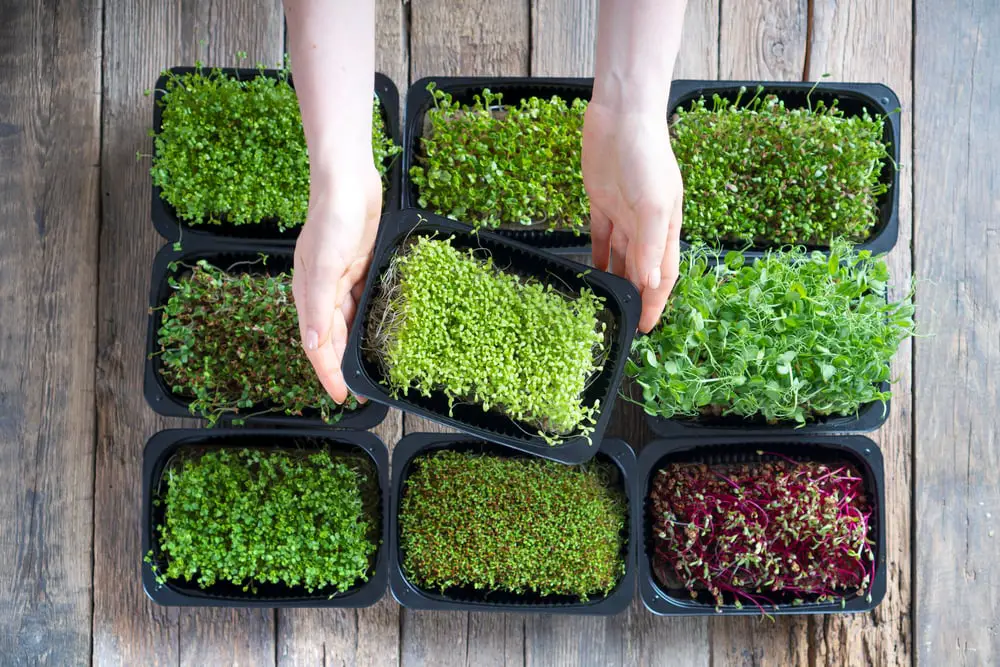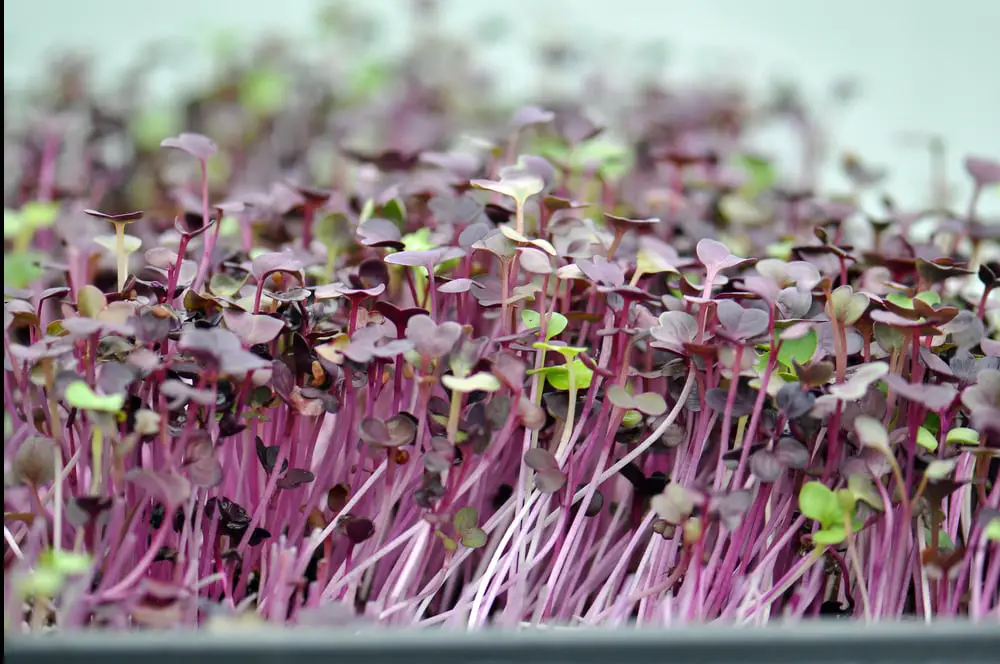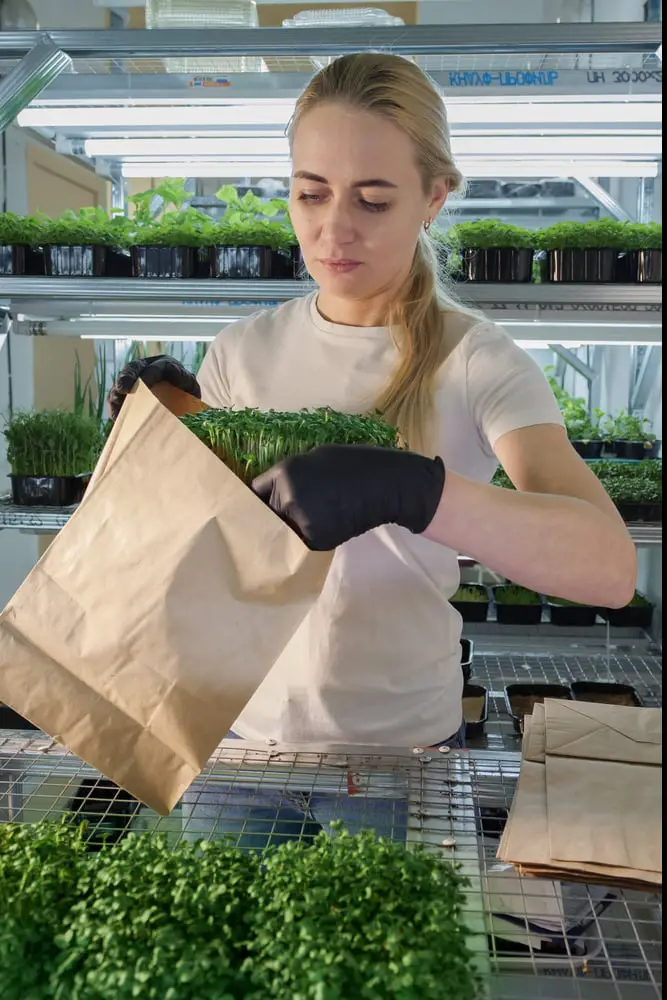While the price you can charge for microgreens tends to fluctuate wildly across different areas, the advent of a healthy online market has helped to standardize prices somewhat. The following should be considered at least reasonable per pound or tray depending on the particular circumstances of their sale:
- Salad Greens: $25-30
- Pea Mix: $20-30
- Arugula: $6-10
- Artisanal Parsley: $20-50
- Cabbage: $14-20
- Broccoli: $5-15
- Cauliflower: $10-15
- Beet: $8-10
- Spinach: $11-15
- Bok Choi: $40-50
- Artisanal Salad Greens: $25-30
- Sunflower Greens: $35-40
- Basil: $20-35
- Cucumber: $10-20
- Fruit Melons: $20-30
- Amaranth: $25-40
- Horseradish: $16-18
- Chia: $14-16
- Onion Greens: $18-26
- Mixed: $3-5
Keep in mind that you can get much higher prices if you part your greens out into 4-6 ounce trays instead of selling them by the pound in bulk. Most microgreen farmers only sell bulk crops to certain types of high-end restaurants anyway, since individual consumers seldom want to purchase several pounds of any type of microgreen.

How Much Do Microgreens Sell For?
Depending on where you are, microgreens might not actually sell for that much. In many rural areas, especially those in the middle of North America, microgreens will normally fetch the same price per pound that full-sized versions of the same crop would.
On the other hand, some urban farmers have found that microgreens can sell for a substantial amount of money in their localities. Haute cuisine-type restaurants in the Detroit and New York City metro areas have been known to pay hundreds for a single tray of just the right kind of ingredients.
Restaurants that serve a certain type of clientele are usually going to pay the most for ingredients, but they’re also going to be the most particular when selecting trays. You might expect to go through 10-20 trays at some places before their chefs will find one that is suitable for their farm-to-table dishes.
Farmers’ markets are almost guaranteed to at least make you a little money, especially if you live in an area where one has a large attendance. The problem is that people who go to them aren’t going to be willing to spend anywhere near as much as a professional restaurateur would be.
In fact, some customers might just be looking for salad greens and have no idea why you’d charge so much for them. That’s why grocery buyers, who sell their products in dedicated stores are usually the best bet.
However, they’re still going to be buying your products in bulk, which means some trays may only go for around $5-10. Select your seeds carefully to maximize profits.

How to Price Microgreens
Consider the amount of energy you use for growth lights as well as the price of water and soil you use for growing your microgreens. Factor these as well as your time into the price you charge.
You’ll want to get at least $2.00 for every dry ounce, assuming that you’re selling 4-6 ounce trays. Some micro crops have heavier leaves per ounce than others. Sunflower shoots weigh much more than, say, chia would.
As a result, you can make more from sunflower greens at the same price, if you can find people who actually want to buy them. Look at your competition and see what they’re charging.
There’s a good chance that you can reasonably shave several dollars off the per ounce price that they’re charging, which can help give buyers an incentive to shop with you as opposed to one of them.
Microgreens Price Per Pound
Prices vary wildly based on market conditions and your buyers. While some uncommon microgreens like raddichio and certain varieties of baby romaine lettuce will fetch much more on the open market, it’s harder to find buyers for these products.
Some 4 oz trays that are sold to chefs will be sold at $20 each, which translates into $80/lb, but this assumes that you’re willing to meet certain exacting standards. More common microgreens like arugula or pea greens might be sold at around $32/lb., which translates into $8 for each 4-ounce tray you grow.
Factor your expenses into any price you set. Some farmers find that it costs them around $15 for each pound of greens they grow.

How Much Does a Tray of Microgreens Cost?
Tray prices depend not only on the cost of the microgreens in question but also the size of the tray. When micro-farmers say tray, they usually mean a container that holds four dry ounces of microgreens.
If this is the case, then you could sell trays for around $8-10 each and expect to do relatively well if you build up a customer base. This would translate into gross receipts of around $32-40 per pound, which is decent if you’re spending less than $15 growing each of your crops.
However, some types of microgreens are very finicky and will need more attention than others. Micro-radishes, for instance, is somewhat uncommon in certain markets because they might grow undersized in indoor growth chambers.
These could reasonably go for prices approaching $15-20 a tray if you can find the right buyer, but your expenses for producing a tray would also be somewhat higher. Keep your eye on the balance sheet each time you start a new tray.
What are the Best Selling Microgreens?
Salad and garnish greens like arugula, spinach, lettuce, and parsley are among the best-selling microgreens. You’ll usually see these in mixed green packages, which can sometimes sell for $25-30 a tray, though that same price per pound is also possible depending on where they’re being sold.
Vegetable microgreens like cabbage, broccoli, and cauliflower are all very popular as well, though this has increased the total number of growers for these crops. As a result, there has been something of a reduction in the price you can reasonably ask for.
Some, like sunflower greens, don’t necessarily sell all that well unless you can find the right kind of customer. However, there’s a good chance that you could actually make more with them due to their weight and physical size.
Restaurant buyers, grocery stores, and individual consumers tend to have the same buying habits in this space, so you might not see much of a difference with the popularity of products regardless of which of these three you’ve elected to work with.
Hi, I’m John Stephens, chief editor and writer for Totalgardener.com. I’ve been gardening and raising animals for over 15 years starting with a small backyard plot in Northern Virginia where I grew corn, potatoes, squash, and using a high mulch technique called the Ruth Stout Method. I also raised ducks and small mammals for meat and eggs in a movable pen similar to the ones used by Joel Salatin. I later moved to Colorado where I experimented with growing greens using aquaponics inside. I eventually added a microgreens setup and home sprouting operation. I’m excited to share everything I’ve learned plus more from the other local gardening and animal raising experts I know.



